Aulos Trade Marks
The Aulos Empire mark.
A Very Old Aulos Mark.

I've only seen this in pictures.
I don't think recorders with this brand were sold in the UK.
(Thanks to Terry, in California, for providing the image file. It is from his 211 tenor, a model I have not seen before, which appears identical to the old 111 tenor illustrated below.)
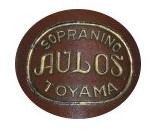
This is a larger image of the brand on the sopranino below.
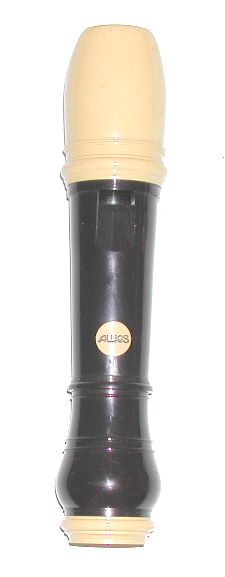
Here is a picture of the head of an early model Aulos 509 Treble. The white insert with the Aulos mark used to be a feature of all the 500 series Aulos models.
Only the treble is markedly different from previous models.
The current 507B-E sopranino is very much the same as the preceding model.
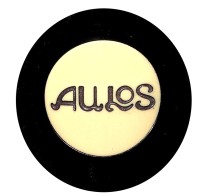
This is an enlarged view of the 'white spot'.
The trade mark is the same long-standing one that is currently (2017) used.
Old Aulos Sopranino Recorders

The upper, three part, sopranino has no model number marked,
but was sold (in the UK) as 207.
It was provided with an orange needle cord bag.
The lower, two part, sopranino is very old and has a pale brown, ribbed plastic, case.
I have no more information. It plays very sweetly.

The old model, on the right, has a noticeably curved (arched) wind way. The later 207, on the left, has the standard straight and flat windway associated with cheaper and older model recorders. The 207 was also available in the light brown colourway.
Old Aulos Descant Recorders
The Aulos 303N descant.

This model became very difficult to get in the UK. It has very good tone and 'real' recorder teachers preferred it to the old (and more expensive!) 205 model.
When the new 205A appeared I gave up the struggle.
The 103N is a single piece, single hole version with fixed thumb rest.
These images were not made at the same time and are not to exactly the same scale.
The Aulos 205 descant.

This was the most popular 'qualty' school descant in the UK. It was loud and resistant to overblowing. Kids loved it!.
Many players were unwilling to take advantage of the strong sound and the model gained a reputation for being flat.
The first production was rather sharp and needed pulling out by about 2mm. Later production had longer bodies and rings were available to fit over the top tenon of old models so as to match their pitch.
Early production has an 'E' in a circle above the thumb hole. Late production is marked 'NO 205-E' just above the lower tenon, at the back of the body, which is 4mm longer. The lower end (of the bell) is flat.
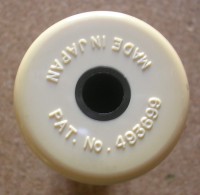
Old Aulos Treble Recorders.
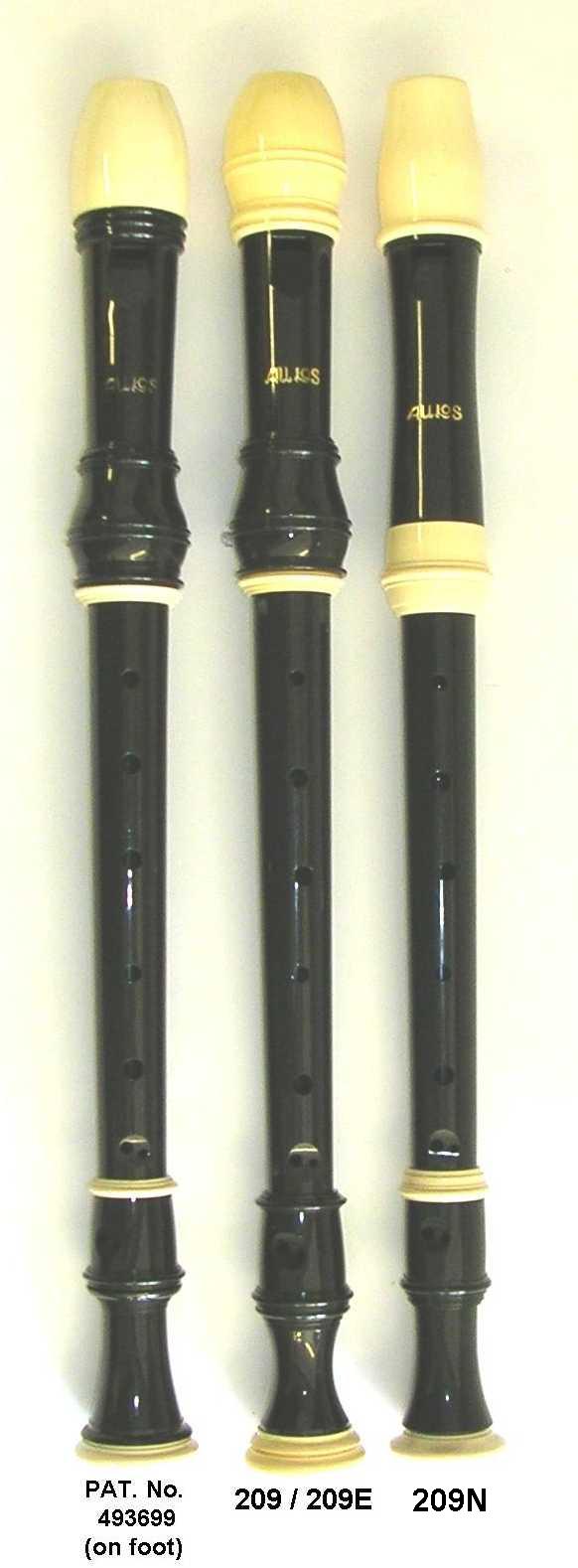

The more recent 309 image is not to quite the same scale as the other.
The model without a number has no 'step' at the lower end of the middle joint. (See below.)
The left hand model was good in its day.
The 209/209E was short lived and rather 'clicky' to play.
The 209N-E (209N) was a winner. The old 309 was good and very like a Coolsma.
Late versions, 309-E, with a white thumb hole bush and bell end, are sightly longer.
They play at the same pitch but the scale is slightly different.
White plastic is no stronger than the standard dark brown.
Thumbhole bushing on plastic models is done because
a hole which is larger on the inside of the instrument cannot be moulded.
The answer to the problem is a separately moulded insert.
There was a 209A treble available for a short time.
The styling, like that of the current 209B treble is based on the current 205A descant.
The early 'A' model treble is slightly longer and bigger in the bore than the 'B' model.
The parts are not interchangeable.
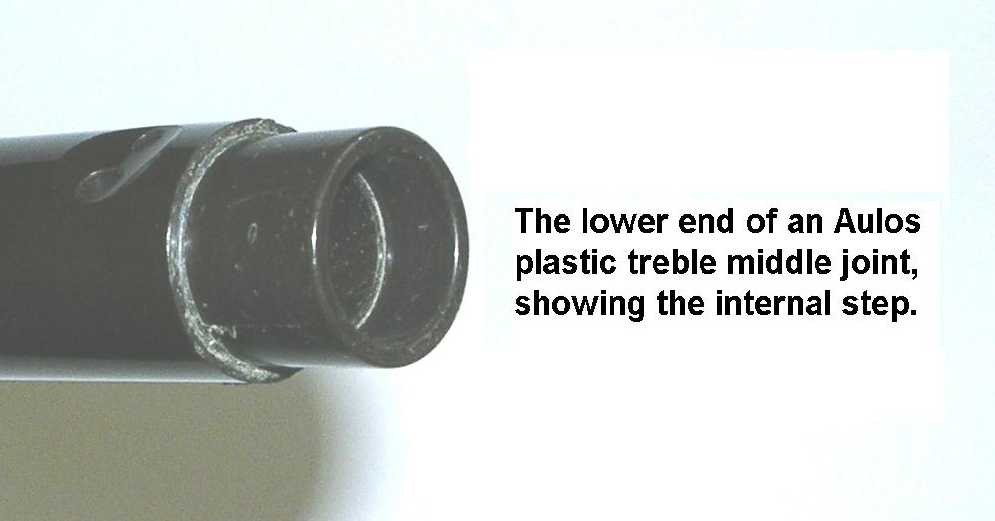
Old Aulos Tenor Recorders.
Here is the discontinued Aulos 311N keyless tenor recorder mentioned below.
Spares are not available.
I have decided to show it horisotally with an Aulos 311 and
manipulated the image sizes so that you can compare their length.
(The head joint is the same for both recorders.)

The Aulos 311N model (above) is keyless and has a removable thumb rest.
The clip on 'arms' are just visible, level with Hole IV.

There is information regarding the Aulos 311 model (above) at the bottom of this page.
There is a fixed thumb rest, but it is a separate welded on part and is often missing.

The discontinued Aulos 311 tenor recorder (above).
It shares the same head as the keyless 311N model.
The head is prone to breakage at the ridge above the bulge.
An effective and invisible repair may be achieved with 'superglue'.
The key is made of plastic and breaks easily.
On this model the outside diameter of the pad cup is 17mm.
There are no longer any replacement keys available.

The long discontinued Aulos 111 tenor recorder.
(The 211 looks identical.)
The key is made of plastic and breaks easily.
On this model the outside diameter of the pad cup is 14mm.
There are no longer any replacement keys available.
Tenor recorders generate more queries than anything else!
They vary in size but they are all large. However, there are
subtle differences in the positions of the holes that make
different models suit different players.
It is well worth trying different models to find out what suits you.
I received a query regarding the Aulos 211N.
This model number pops up in web searches for a keyless Aulos tenor.
I have come to the conclusion that this model does not exist.
In some cases the recorder illustrated is a 311N, in others it is the 211A.
I put this down to careless editing when updating details
when the 311N was discontinued.
If you know better and can provide more insight and images of a recorder
and case or moulded part showing 211N please do contact me.
Old Aulos Bass Recorders.
The early Aulos basses are straight and the mouth pipe is 'S' or 'Z' shaped, entering the cap from the side. The keys are made of polished white metal and are of two types. On the foot joint, the older ones have long, cranked levers, while the newer ones have shorter, straight levers. I think the old straight basses also have smaller diameter mouth pipes. Both sizes have cork lapping.
Aulos basses with side entry caps have the same size cap fitting (this includes the accessory 'direct blow' cap). Old style side entry caps are available but matching pipes are not obtainable. (I can adapt the current Aulos beak with a 12mm. socket so that it fits any pipe blown bass. I can also make a custom beak from beech wood.)
I have produced a page of general information on bass recorders... click here.

This is the last
of the old style
Aulos basses.
533E
(This model was
discontinued in 1991.
No spares are available.)

For comparison,
this is the (2015)
current model
Aulos bass.
533B